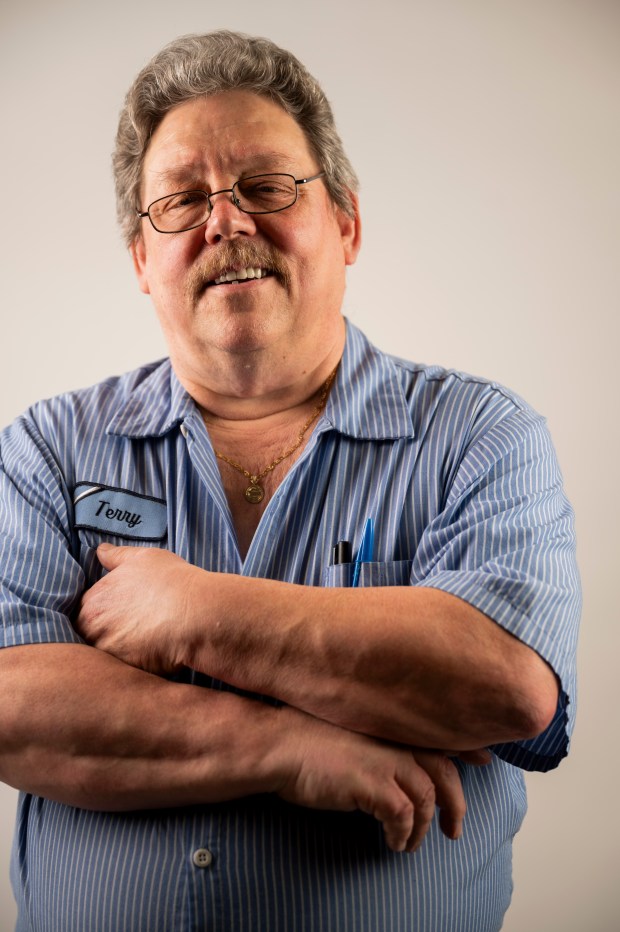
When the Chicago Tribune moved the last of its printing operations from the basement of Tribune Tower to the Freedom Center in 1982, the new $185 million plant by the Chicago River was billed as the largest newspaper production facility in North America.
On Saturday, the Freedom Center printed its final edition of the Chicago Tribune before facing a demolition deadline and planned redevelopment into a casino. Tribune Publishing is shifting printing operations to the northwest suburban Daily Herald plant, which it purchased in May 2023.
For dozens of production workers, some of whom spent decades tending to 10 massive Goss Metroliner offset presses churning out upward of a million copies of the Tribune and other newspapers each day, their Freedom Center career was filled with sacrifice, camaraderie and by its nature, countless sleepless nights.
Their often nocturnal shifts, working while the city slept to ensure that daily newspapers would arrive each morning, meant missing everything from weddings to school plays. But the workers felt pride in their craft, printing the first draft of history for others to read over coffee.
Declining print circulation in the digital age slowed production, diminished the employee ranks, curtailed raises and made the sprawling plant expendable under new ownership. The Sunday edition will be the last Chicago Tribune printed at the Freedom Center, while other titles will make the move to Schaumburg by June 2.
For some long-tenured press operators such as Andrew Whitaker, 69, who started as a 24-year-old in 1979, the final production runs at the Freedom Center will be the end of the line for their printing careers after choosing a severance package over the commute to Schaumburg.
Whitaker reminisced about arriving at the spacious new Freedom Center digs and finding the noise of 10 giant presses running nonstop to be “deafening.” More than four decades later, he still takes pride in the work.
“You almost feel like an artist,” Whitaker said. “People really don’t understand the logistics that go into the printing process. It seems like the paper just appears, but there’s a lot to it.” Whitaker plans to retire in June.

Mitch Britton, 65, a South Side resident, started at the Tribune Tower pressroom in 1978 while studying air conditioning/heating repair at Kennedy-King Junior College. He soon gave up his intended career to become a press operator. Britton was among the last to move over to Freedom Center, staying behind until the final printing runs at Tribune Tower in September 1982.
“Back in the day you live, breathe ink all the time,” Britton said. “You got over here, it was like a whole new world.”
Britton’s son has been working with him at the Freedom Center for the past 20 years, along with dozens of co-workers he considers an extended family after decades in the trenches together.
“It’s been a wonderful experience,” Britton said. “I don’t regret not being an air conditioning/heating technician.”
Still short of full retirement age, Britton is making the move to Schaumburg.

Terry Ford, 64, of River Grove, a 41-year plant veteran who serves as crew supervisor, started as a part-timer at Freedom Center in 1983 and worked his way up as the plant ran at full capacity nearly round the clock.
Eating wasn’t allowed near the $10 million, state-of-the-art offset printing presses, but you could smoke, with ashtrays on every door, he said. The plant was so busy, it took Ford years to get his own locker.
“There were hundreds of lockers in there and if you didn’t have one, you had to wait until somebody retired or quit to get a locker,” Ford said.
The move to Schaumburg accelerated his own decision to join the ranks of the retired in June.

Night shift press operator Dollie Merritt has worked at the Freedom Center for 22 years.
Before the pressroom, she worked in packaging, building services and the ink room. She’s retiring when the center shuts down and she plans to use her time to travel.

Scott Seno, a night shift press operator, has worked at the Freedom Center for 24 years.
“Being around my co-workers for 24 years, we spend more time with the people we work with than with our family members so we have really good friendships and even outside of work we spend to spend a lot of time together,” Seno said.
Deanna Warner, a night shift press operator, started in 2003. She enjoyed how every day on the job was different.
“You may have one night that we are running up and down the stairs for 12 hours straight. You might have another day where we are done an hour early,” Warner said.

Franklin Ford, 73, of Calumet Park, has been working at Freedom Center for 22 years, coming to the Chicago Tribune printing plant after 12 years at the Daily Southtown.
Before that, he worked at the Solo Cup factory in the Ford City neighborhood on Chicago’s Southwest Side and at a commercial printer in West Chicago. Ford “retired” 10 years ago, but has continued to work part-time at the Freedom Center. Come June, his retirement will be full-time. “I’m going to retire again and try to improve my golf game,” Ford said.
While Ford enjoyed his long career as a press operator, he believes the job is becoming obsolete in the digital media age. “This is a dying trade,” Ford said. “It’s hard to admit it, but that’s true. This trade is on its way out.”
Sign up to receive the Vintage Chicago Tribune newsletter at chicagotribune.com/newsletters for more photos and stories from the Tribune’s archives. Have an idea for Vintage Chicago Tribune? Share it with Ron Grossman and Marianne Mather at rgrossman@chicagotribune.com and mmather@chicagotribune.com.













